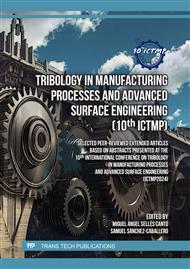[1]
Shi-Gang, X., Li-Xin, S., Rong-Gen, Z. and Xing-Fang, H., 2005. Properties of aluminium oxide coating on aluminium alloy produced by micro-arc oxidation. Surface and Coatings Technology, 199(2-3), pp.184-188.
DOI: 10.1016/j.surfcoat.2004.11.044
Google Scholar
[2]
Yin, C., Zhu, M., Zeng, T., Sun, J., Zhang, R., Zhao, J., Wang, L. and Shao, J., 2021. Al 2 O 3 anti-reflection coatings with graded-refractive index profile for laser applications. Optical Materials Express, 11(3), pp.875-883.
DOI: 10.1364/ome.418174
Google Scholar
[3]
Reddy, I.N., Reddy, V.R., Sridhara, N., Rao, V.S., Bhattacharya, M., Bandyopadhyay, P., Basavaraja, S., Mukhopadhyay, A.K., Sharma, A.K. and Dey, A., 2014. Pulsed rf magnetron sputtered alumina thin films. Ceramics International, 40(7), pp.9571-9582.
DOI: 10.1016/j.ceramint.2014.02.032
Google Scholar
[4]
Oke, J.A. and Jen, T.C., 2022. Atomic layer deposition and other thin film deposition techniques: from principles to film properties. Journal of Materials Research and Technology, 21, pp.2481-2514.
DOI: 10.1016/j.jmrt.2022.10.064
Google Scholar
[5]
Kelly, P.J. and Arnell, R.D., 2000. Magnetron sputtering: a review of recent developments and applications. Vacuum, 56(3), pp.159-172.
DOI: 10.1016/s0042-207x(99)00189-x
Google Scholar
[6]
NOIKAEW, Busarin, Laksana WANGMOOKLANG, Saisamorn NIYOMSOAN, and Siriporn LARPKIATTAWORN. "Preparation of transparent alumina thin films deposited by RF magnetron sputtering." Journal of Metals, Materials and Minerals 31, no. 2 (2021): 96-103.
DOI: 10.55713/jmmm.v31i2.1066
Google Scholar
[7]
Cremer, R., Reichert, K., Neuschütz, D., Erkens, G. and Leyendecker, T., 2003. Sputter deposition of crystalline alumina coatings. Surface and Coatings Technology, 163, pp.157-163.
DOI: 10.1016/s0257-8972(02)00480-2
Google Scholar
[8]
Shamala, K.S., Murthy, L.C.S. and Rao, K.N., 2004. Studies on optical and dielectric properties of Al2O3 thin films prepared by electron beam evaporation and spray pyrolysis method. Materials Science and Engineering: B, 106(3), pp.269-274.
DOI: 10.1016/j.mseb.2003.09.036
Google Scholar
[9]
Zahid, M.A., Khokhar, M.Q., Park, S., Hussain, S.Q., Kim, Y. and Yi, J., 2022. Influence of Al2O3 /IZO double-layer antireflective coating on the front side of rear emitter silicon heterojunction solar cell. Vacuum, 200, p.110967.
DOI: 10.1016/j.vacuum.2022.110967
Google Scholar
[10]
Lin, Jianliang. "High rate reactive sputtering of Al2O3 coatings by HiPIMS." Surface and Coatings Technology 357 (2019): 402-411.
DOI: 10.1016/j.surfcoat.2018.10.024
Google Scholar
[11]
Ferreira, Marta P., D. Martínez-Martínez, J-B. Chemin, and P. Choquet. "Tuning the characteristics of Al2O3 thin films using different pulse configurations: Mid-frequency, high-power impulse magnetron sputtering, and their combination." Surface and Coatings Technology 466 (2023): 129648.
DOI: 10.1016/j.surfcoat.2023.129648
Google Scholar
[12]
Barroso, G., Li, Q., Bordia, R.K. and Motz, G., 2019. Polymeric and ceramic silicon-based coatings–a review. Journal of materials chemistry A, 7(5), pp.1936-1963.
DOI: 10.1039/c8ta09054h
Google Scholar
[13]
Khan, S.B., Wu, H. and Zhang, Z., 2018. Omnidirectional SiO2 AR coatings. Coatings, 8(6), p.210.
DOI: 10.3390/coatings8060210
Google Scholar
[14]
Williamson, E.H., Gee, M., Robertson, D., Watts, J.F., Whiting, M.J. and Yeomans, J.A., 2022. A comparative study of the wear performance of hard coatings for nuclear applications. Wear, 488, p.204124.
DOI: 10.1016/j.wear.2021.204124
Google Scholar
[15]
P. Aldebert and J.P. Traverse. Neutron diffraction study of structural characteristics and ionic mobiliy of alpha- Al2O3 at high temperatures. Journal of the American Ceramic Society, 65:460–464, 1982.
DOI: 10.1111/j.1151-2916.1982.tb10515.x
Google Scholar
[16]
Cheng, Y., Chu, C. and Zhou, P., 2020. Low-temperature deposition and hardness enhancement of α-(Al, Cr) 2O3 films by reactive high power pulsed magnetron sputtering. Materials Research Express, 7(11), p.116407.
DOI: 10.1088/2053-1591/abc7e1
Google Scholar



